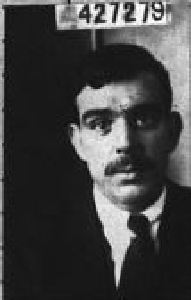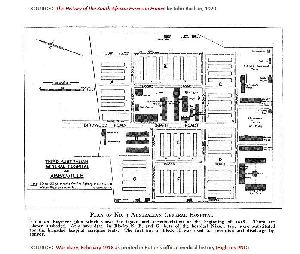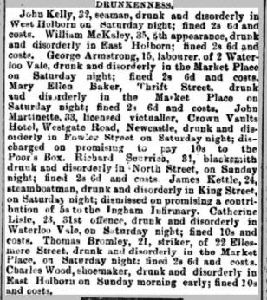
Herbert William Kettle, Williams elder brother

3rd Australian General Hospital at Abbeville 1918

Shields Daily News Tuesday 20th November 1888
In 1875 James Kettle was discharged for throwing stones on the 26th February 1875 with an Edward Lincoln, Four other boys were fined 2s 6d and costs, John Grice, Wiliam Lawson, William Swinbanks James Fairbairn, were summoned for throwing stones in Charlotte Street, South Shields.
James had been drunk and disorderly in King Street on the 17th November 1888, and promised to make a donation to the Ingham Infirmary of 5s.
They had 10 children, six lived and 4 died, three were born at 1 Ellesmere Street, three of them served in the forces in World War 1. Herbert William Kettle, born 7th June 1889, baptised on the 23rd June 1889. James Kettle, born 6th June 1888, baptised on the 27th June 1888, at St Hilda's church, who enlisted in the 4th Battalion Durham Light Infantry on the 16th January 1906, aged 17 years 7 months, service number 8338, John Kettle born 2nd June 1891, he enlisted into the Durham Light Infantry, died 1930, and a William Walderham Kettle, born 3rd August 1895, [not to be confused with the professional footballer called the same name], Christine Kettle, born 22nd May 1893 and Hilda born 27th November 1896, baptised on the 23rd December 1896, at St Hilda's church South Shields, she married a Henry Jacobs in 1919.
James died 22nd June 1948 at Ingham Infirmary and left effects of £304 4s 8d to Hilda Jacobs his younger sister.
William Walderham Kettle emigrated to Australia, we believe in July 1914 on-board the Hawkes Bay, embarking at Victoria.
He was a painter and resided at Bendigo, Victoria, Australia, and was unmarried.
William attested on the 10th June, but was enlisted into A 9th 'D' Battalion at Ascot Vale which became the 8th Battalion Australian Infantry Battalion, service number 3373 on the 10th July 1915. His declared age then was 19 years 1 month. William was 5 feet 2 inches high, weighed 84lbs with a fair complexion, brown eyes and light brown hair. In addition he had no distinguishing marks.
Infantry Battalions 5 to 8 were part of the 2nd BrigadeThe 5th, 6th, 7th and 8th Battalion’s were infantry units raised for the AIF during the First World War and was recruited from Victoria. All four battalions, formed the 2nd Brigade. The 8th Battalion was raised from rural Victoria by Lieutenant Colonel William Bolton.
The battalions was raised within a fortnight of the declaration of war in August 1914 and embarked two months later. After a short stop in Albany, Western Australia, the battalion proceeded to Egypt, arriving on the 2nd December 1914. It later took part in the ANZAC landing on the 25th April 1915, as part of the second wave. It was led by Lieutenant Colonel D. S. Wanliss, the officer who had raised the 5th battalion. Ten days after the landing the 2nd Brigade was transferred from ANZAC to Cape Helles to help in the attack on the village of Krithia. The attack captured little ground but cost the brigade almost a third of its strength. The Victorian battalions forming the 2nd Brigade returned to ANZAC to help defend the beachhead. In August the Brigade fought at the battle of Lone Pine. While holding positions captured by the 1st Brigade, the battalion served at ANZAC until the evacuation in December.
After the withdrawal from Gallipoli, the battalions returned to Egypt. On March 22nd 1916 the transport Section left for Alexandria, and on the 26th March the rest of the Battalion sailed for France, aboard the HMT Megantic , and the Western Front. From then until 1918 the battalions were heavily involved in operations against the German Army. The battalion’s first major action in France was at Pozières in the Somme valley in July 1916. After Pozières the battalion fought near Ypres, in Flanders, returning to the Somme for winter.
In 1917, the battalions took part in the operations that followed-up the German withdrawal to the Hindenburg Line, and then returned to Belgium to join the great offensive launched to the east of Ypres.
In March and April 1918 the battalions helped stop the German spring offensive and later on the 8th August 1918 took part in the Allies’ own offensive, launched near Amiens. The advance by British and empire troops was the greatest success in a single day on the Western Front. The battalions continued operations until late September 1918. At 11 am on the 11th November 1918, the war finally ended. The November armistice was followed by the peace treaty of Versailles signed on the 28th June 1919.
William missed the Gallipoli campaign but was embarked at Melbourne on the H.M.A.T., A71 'Nestor' on the 11th October 1915 as part of the 11th wave of reinforcements.
On the 29th March 1916 he proceeded to join the B.E.F., from Alexandria, [where his battalion was stationed after the Gallipoli campaign], where he was disembarked at Marseilles on the 4th Apil 1916. He was at the IBD base at Etaples ['Eat Apples'], where he proceeded to join his battalion. William joined his battalion on the 17th May 1916, and was in 'D' Company where he was taken on strength with the 8th Battalion.
On Monday 24th July he was wounded by a gun shot wound to the right Axilla, [right armpit], near Pozieres, and was sent to the 3rd Australian General Hospital.
William then was sent to the UK, on the hospital ship H.S., 'Gloucester Castle' from Le Havre and was taken to Graylingwell War Hospital, Chichester, arriving on the 29th July 1916.
When he recovered from his wounds, he marched to Perham Downs arriving there on the 4th September 1916, and was taken on the strength of the 2nd Training Battalion at Perham Downs.
Australian troops actually began arriving in England in mid-1915, prior to the AIF being deployed on the Western Front. During the Gallipoli campaign thousands of wounded Australian soldiers were shipped to English hospitals, but the question soon arose regarding what to do with the convalescing men once they had been discharged, as they, unlike their British counterparts, had no home depot to report to. In response to this a special depot was created in May 1915 at Monte Video Camp near Weymouth, Dorset, on the south coast of England. The depot’s primary aim was to receive and train men who would likely be fit for return to the front. Men who were marked for return to Australia were placed at a second camp at nearby Westham. The Weymouth camp was therefore the first of what would be four Command Depots whose main purpose would be to receive Australian soldiers that had been discharged from hospital and deemed fit to return to the front line within a period of about three months. Having already been part of a fighting unit they would have already experienced training, so the focus was very much on getting the men back to fitness, hardening them up for return to the front line.
For the soldiers who had been wounded and shipped back to hospitals in England, there was a defined process for their recovery and training. As no Australian General Hospitals were established in Britain during the conflict (1AGH not arriving in England until after the Armistice), Australian casualties arriving from France went to British hospitals right across the country. Once well enough to be moved, they were transferred to the Australian Auxiliary Hospitals in Harefield, Middlesex, Dartford in Kent and at Southall in West London. Upon discharge from hospital they were then sent to one of the four Command Depots in Wiltshire and Dorset to convalesce and continue their recovery:
Command Depot No.1, was established in the summer 1916 at Perham Down (close to Tidworth), and was transferred to Sutton Veny in October 1917.
Perham Down is situated a mile from Ludgershall station, Perham Down was initially used at the outbreak of war by some of the new Kitchener battalions. In 1916 Australia’s No.1 Command Depot was established at Perham Down, accommodating 4,000 men, until it moved to Sutton Veny in October 1917. The Australian Overseas Training Brigade, designed to toughen up convalescent men prior to being sent back to the front and for combat was established at Perham Down from June to October 1917, when it was transferred to Sand Hill (Longbridge Deverill).
Unlike many camps built in Wiltshire during the war, Perham Down continued with many of the wooden huts being replaced by brick buildings and is now one of the major garrisons on the Salisbury Plain. Ludgershall station, once a key transport hub for arriving and departing troops has now gone, but the railway line remains photograph showing where the station was located, with the platform having been on the right).
On the 2nd February 1917 he embarked at Folkestone for France on the S.S., Victoria and marched in to the Etaples Infantry Base, he then joined the 8th Battalion on the 10th February 1917. On the 20th September 1917 he is promoted to Lance-Corporal, [from the advice of a Corporal Stewart], then temporary Corporal on the 1st November 1917.
On the 26th January 1918 he is granted 14 days leave, and returns from leave on the 13th February. He is then promoted Corporal permanently from the 20th April 1918.
His record records a Court Martial which took place at Larkhill on the 26th December 1916, When William was at Perham Downs he was admonished over a charge of 'Disobeying a standing order of being out of bounds without a pass.' on the 19th October 1916.
Then his Court Martial again was reviewed by the Australian Infantry Forces HQ', the charge happened at Perham Downs Absent without leave from 7.45 am 27th October 1916 till he returned to 'D' Company at 6pm 27th November 1916. They decided on forfeiture of 90 days pay and reduce the period under charge to just 20 days. William pleaded guilty.
William is promoted to a Corporal due to the death of Corporal Whelan in action on the 14th April 1918, in the field. William then is disembarked at Folkestone on the 30th July 1918 and joins the 1st Training Battalion. He then is based at Warminster. Then at the beginning of August he is transferred to Tidworth.
Whilst he was at Sutton Veny in August he was absent without leave from the 18th August 1918 till the 19th August at Bristol where he was apprehended by a British Police Constable at 5.30 am.
September, still a Corporal he is at Tidworth teaching Musketry skills. On the 23rd September, William is qualified as a 1st Class Musketry shot, he had been attending the 23rd Rifle Course at the Australian School of Musketry from the 22nd August to the 21st September.
On the 19th January he applies for Acting Sergeant at Sutton Veny where he is located still. He is responsible of training new drafts in the 1st Training Battalion. He is now detached from the Permanent cadres.
On the 28th March 1919 he returns back to Australia on the 'City of Poona' where he disembarked at Melbourne on the 14th May 1919. He was finally discharged on the 6th July 1919.
He lived in Brunswick (an inner suburb of Melbourne) most of his life, moving to Rosebud, on the Bay, after he retired. He married Williamina in 1924 and died in 1989 (aged 94). After the war he joined the Citizen Military Forces (CMF – now the Army Reserve) and allocated the number V91063. Their house in Rosebud was a very modest weatherboard one and was sold shortly after his death for $64,000.
Research: Michael White/Paul Joannou/James Pasby
8th Infantry Battalion at the Somme
Training Camps of the UK in WW1 for the Australian Forces

